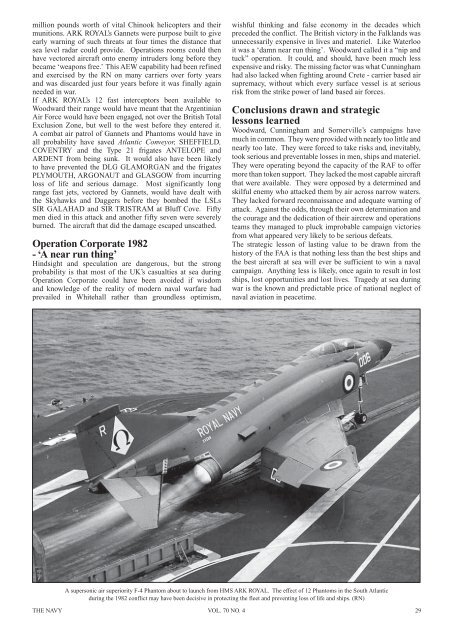The Navy Vol_70_No_4 Oct 2008 - Navy League of Australia
The Navy Vol_70_No_4 Oct 2008 - Navy League of Australia
The Navy Vol_70_No_4 Oct 2008 - Navy League of Australia
You also want an ePaper? Increase the reach of your titles
YUMPU automatically turns print PDFs into web optimized ePapers that Google loves.
million pounds worth <strong>of</strong> vital Chinook helicopters and their<br />
munitions. ARK ROYAL’s Gannets were purpose built to give<br />
early warning <strong>of</strong> such threats at four times the distance that<br />
sea level radar could provide. Operations rooms could then<br />
have vectored aircraft onto enemy intruders long before they<br />
became ‘weapons free.’ This AEW capability had been refined<br />
and exercised by the RN on many carriers over forty years<br />
and was discarded just four years before it was finally again<br />
needed in war.<br />
If ARK ROYAL’s 12 fast interceptors been available to<br />
Woodward their range would have meant that the Argentinian<br />
Air Force would have been engaged, not over the British Total<br />
Exclusion Zone, but well to the west before they entered it.<br />
A combat air patrol <strong>of</strong> Gannets and Phantoms would have in<br />
all probability have saved Atlantic Conveyor, SHEFFIELD,<br />
COVENTRY and the Type 21 frigates ANTELOPE and<br />
ARDENT from being sunk. It would also have been likely<br />
to have prevented the DLG GLAMORGAN and the frigates<br />
PLYMOUTH, ARGONAUT and GLASGOW from incurring<br />
loss <strong>of</strong> life and serious damage. Most significantly long<br />
range fast jets, vectored by Gannets, would have dealt with<br />
the Skyhawks and Daggers before they bombed the LSLs<br />
SIR GALAHAD and SIR TRISTRAM at Bluff Cove. Fifty<br />
men died in this attack and another fifty seven were severely<br />
burned. <strong>The</strong> aircraft that did the damage escaped unscathed.<br />
Operation Corporate 1982<br />
- ‘A near run thing’<br />
Hindsight and speculation are dangerous, but the strong<br />
probability is that most <strong>of</strong> the UK’s casualties at sea during<br />
Operation Corporate could have been avoided if wisdom<br />
and knowledge <strong>of</strong> the reality <strong>of</strong> modern naval warfare had<br />
prevailed in Whitehall rather than groundless optimism,<br />
wishful thinking and false economy in the decades which<br />
preceded the conflict. <strong>The</strong> British victory in the Falklands was<br />
unnecessarily expensive in lives and materiel. Like Waterloo<br />
it was a ‘damn near run thing’. Woodward called it a “nip and<br />
tuck” operation. It could, and should, have been much less<br />
expensive and risky. <strong>The</strong> missing factor was what Cunningham<br />
had also lacked when fighting around Crete - carrier based air<br />
supremacy, without which every surface vessel is at serious<br />
risk from the strike power <strong>of</strong> land based air forces.<br />
Conclusions drawn and strategic<br />
lessons learned<br />
Woodward, Cunningham and Somerville’s campaigns have<br />
much in common. <strong>The</strong>y were provided with nearly too little and<br />
nearly too late. <strong>The</strong>y were forced to take risks and, inevitably,<br />
took serious and preventable losses in men, ships and materiel.<br />
<strong>The</strong>y were operating beyond the capacity <strong>of</strong> the RAF to <strong>of</strong>fer<br />
more than token support. <strong>The</strong>y lacked the most capable aircraft<br />
that were available. <strong>The</strong>y were opposed by a determined and<br />
skilful enemy who attacked them by air across narrow waters.<br />
<strong>The</strong>y lacked forward reconnaissance and adequate warning <strong>of</strong><br />
attack. Against the odds, through their own determination and<br />
the courage and the dedication <strong>of</strong> their aircrew and operations<br />
teams they managed to pluck improbable campaign victories<br />
from what appeared very likely to be serious defeats.<br />
<strong>The</strong> strategic lesson <strong>of</strong> lasting value to be drawn from the<br />
history <strong>of</strong> the FAA is that nothing less than the best ships and<br />
the best aircraft at sea will ever be sufficient to win a naval<br />
campaign. Anything less is likely, once again to result in lost<br />
ships, lost opportunities and lost lives. Tragedy at sea during<br />
war is the known and predictable price <strong>of</strong> national neglect <strong>of</strong><br />
naval aviation in peacetime.<br />
A supersonic air superiority F-4 Phantom about to launch from HMS ARK ROYAL. <strong>The</strong> effect <strong>of</strong> 12 Phantoms in the South Atlantic<br />
during the 1982 conflict may have been decisive in protecting the fleet and preventing loss <strong>of</strong> life and ships. (RN)<br />
THE NAVY VOL. <strong>70</strong> NO. 4 29

















